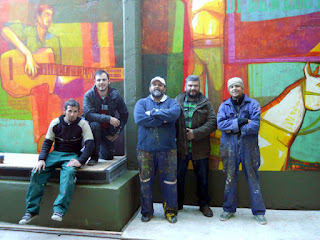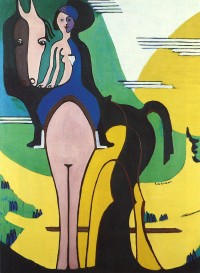Decir Kirchner es decir expresionismo. Pero el que fuera cofundador del grupo Die Brücke (El puente) en 1905, tuvo una vida artística larga y fecunda en la que merece la pena detenerse.
En este blog, con fecha 10 de octubre de 2010, realicé una entrada dedicada a este artista junto a otros tantos expresionistas centrándome más que nada en ese movimiento.
El MOMA de Nueva York presentó hace unos años una extensa exposición de la misma época, pero dejaba un poco de lado los años primeros y sobre todo los años cercanos a su muerte.
RETRATO DEL PINTOR HECKEL 1907
Hoy quiero detenerme un poco en esa obra que no tuvo tanta repercusión como la realizada junto a sus compañeros expresionistas, pero que no por ello es de menor interés.
Una exposición en Madrid ha sido el incentivo final para hacerlo. La Fundación MAPFRE, nos trae una retrospectiva de Kirchner que todo aquel que ame el arte debería visitar. En su sala de Recoletos, nos ofrece un recorrido más que interesante, no sólo por la obra en sí, sino porque Kirchner vivió en unos años convulsos y su vida y el momento histórico se ven reflejados en su magnífica obra. No podemos olvidar que nació en 1880 y su suicidio tuvo lugar en 1938, con lo cual se podría decir que los años de las dos guerras mundiales y la época de entreguerras marcan toda su vida.
En la primera fue llamado a filas, saliendo fuertemente impactado y enfermo y la segunda guerra mundial, o mejor dicho los años precedentes, le llevarían al suicidio.
La retrospectiva está dividida en diferentes fases que nos hace viajar por su obra mostrando los cambios artísticos en función de los terribles momentos vividos.
LA FOTOGRAFÍA. FRÄNZI FEHRMANN.1910
La sensibilidad de un artista que sabe transmitir con la obra su momento personal y sobre todo el momento histórico que vive, da lugar a conocer la historia de primera mano y Kirchner fue un experto en ello y además lo hizo valiéndose de todos los medios a su alcance.
Son cinco las épocas o fases que se muestran y como antes menciono, la época expresionista es posiblemente la que más marca la exposición, no sólo porque es la más conocida, sino porque casi toda su vida artística estuvo fuertemente influenciada por ella. Pero hay mucho que ver en esta retrospectiva. Otra premisa que perdura durante toda su obra es el fuerte contraste de colores puros.
PAREJA DE ACROBATAS.MADERA. 1932
No obstante, puesto que en su día escribí sobre su aportación al expresionismo, hoy quiero detenerme en el artista que no sólo cultivó la pintura sino muchas otras disciplinas y todas con esa sensibilidad especial. Su fecunda obra abarca desde trabajos de dibujo y grabado, pasando por la escultura, decoración de interiores, artesanía textil, trabajos de arquitectura y fotografía. Un denominador común en prácticamente toda su obra es la figura humana presente, tanto en su obra pictórica, como en la fotográfica o en la escultura.
La figura está presente, aislada o en grupo, en exteriores o en interiores, en fin, en todas las variantes posibles. Es interesante su última etapa cuando el giro que toma su obra es sorprendente y que coincide con esa actividad artística tan versátil.
MUCHACHA DESNUDA CON LA SOMBRA DE UNA RAMA.1905
Siendo estudiante de arquitectura fundaría junto a otros compañeros “El Puente” movimiento que adquiriría gran proyección sobre todo cuando se unieron para exponer con el otro grupo expresionista, “El jinete azul”.
En la obra de esos años destaca los fuertes colores en forma de manchas y de pinceladas sueltas. La marcada factura fauvista es indiscutible. Delante de los lienzos de esa época no podemos dejar de recordar a Matisse o a un Van Gogh de quién también se ve la influencia.
MUJER YACENTE CON CAMISOLA BLANCA. 1909
En continua experimentación con formas y colores y como muchos artistas de la época con la vista puesta en el arte primitivo su trabajo pronto dejó la forma más académica para mostrar una obra diferente, luminosa y bien alejada de lo que se entiende por tradicional.
DOS MUJERES CON AGUAMANIL 1913
La época de la primera guerra mundial marcaría profundamente al artista. Sus anteriores excesos y vida de desorden, así como la incapacidad de soportar una vida militar al ser llamado a filas, le llevan a ser ingresado en diferentes sanatorios.
AUTORRETRATO CON MUCHACHAS 1914-1915
Esto no detiene su vida artística y el horror del momento histórico y sus demonios personales se verían reflejados en los numerosos autorretratos y también en los retratos del personal médico de los lugares en los que estuvo internado.
En 1917 llega a Davos. Es interesante señalar esta fecha y lugar porque es donde permanecería hasta el final de sus días. Pero no solamente hay que detenerse en esta época por ese motivo. Su obra se amplía, en cuanto a temas se refiere. Los paisajes de los Alpes se hacen presentes. Y dice mucho de la sensibilidad de este artista cuya obra artística e incluso su propia vida había sido más urbana que rural y que ahora se abre a un mundo diferente que sin duda le llegó a fascinar.
VISTA ALPINA 1917-1919
La naturaleza, los montes y la vida del campo se apoderan de su obra de tal forma que sería considerado uno de los mejores pintores de las montañas de los Alpes. Bien por su momento personal, bien por el entorno, su obra va girando hacia un tono más tranquilo y mucho menos atormentado que la realizada hasta ese momento.
RIDER 1931-32
Esta época de Davos, ya entrando en la última etapa de su vida, es uno de los momentos que anteriormente mencionaba como de gran interés.
Kirchner, conocedor del movimiento de La Bauhaus, de la obra de Le Corbusier, y de los movimientos contemporáneos, va a ir adquiriendo una factura más abstracta en su obra.
DESNUDO EN NARANJA Y AMARILLO 1929 1930
Pero aunque retirado en Davos, sigue la actualidad y el movimiento nazi con preocupación. Al igual que muchos de sus compañeros expresionistas ve su obra retirada de los museos y él mismo es expulsado de la Academia de las Artes. La anexión de Austria a Alemania no hace más que aumentar esa inquietud. La sospecha de que Suiza puede ser invadida le lleva a suicidarse en 1938, no sin antes destruir una buena parte de su obra. Fue enterrado en Davos en dónde también se encuentra un museo dedicado a su obra.
http://www.kirchnermuseum.ch/sites/en/e_l_kirchner.html
La obra de Ernst Ludwig no ha sido demasiado conocida salvo para los que hemos estudiado los diversos movimientos artísticos. Es por ello que esta exposición de Fundación MAPFRE es de gran valor, por su sencillez a la hora de exponer la obra y sobre todo por ser una de las retrospectivas más completas que se han visto en este país.
NOTAS: Para mejor visualizar la fotografía “picar” con el ratón encima de las que interesen.
Para la lectura de entradas anteriores, ir a la ventana de la derecha y “picar” en los años y meses. Se desplegarán los títulos correspondientes a cada fecha.
Para la elección de otro IDIOMA ir con el cursor al final de la página.
Fuentes consultadas:
Expresionismo. Dietmar Elger Edit.Taschen
Historia visual del Arte. Claude Frontisi. Edit. Larousse.
Historia del Arte del Siglo XX. Varios autores. Edit. Taschen.
Catálogo para la Retrospectiva de Ernst Ludwig Kirchner. Fundación MAPFRE.


















































